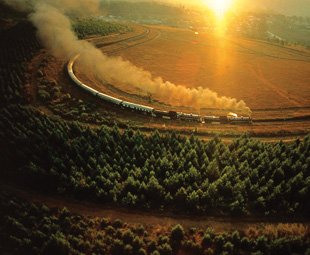A track through time

Trains have catapulted development and shrunk the world, but are they still relevant today? We track through time to find the answer.
The history of trains, as we know them, spans the past two centuries of modern civilisation. According to the website Train History, the advent of trains drastically changed industry, human expansion and the way we travel on a daily basis.
“From the first time a steam train rolled over the railways of industrial England, in the early 1800s – to modern times when bullet trains carry thousands of passengers at incredible speeds, and freight trains carry substantial amounts of the world’s goods – trains enabled us to develop our civilisation with unexpected consequences,” the site relates.
The world became smaller as a trip, that would have taken months, could be completed in mere days. “Industrial manufacture could be powered with infinite amounts of raw materials and outgoing transport of finished goods. The ability to travel fast (long before the first aeroplanes were discovered) also created the need to implement standardised time zones across the entire world,” Train History explains.
These fast tracking wonders have had many guises through the ages: from steam, diesel and electric locomotives to those that run with combined engines. Train tracks have also changed dramatically …
There are now common and electrified railways, high-speed rail and Maglev (a railway system that uses the power of magnets both to drive and suspend vehicles above the tracks).
“Trains that use magnets to levitate above the tracks might sound like something from Back to the Future, but the concept of magnetic levitation has been around for many years,” explains Roger Goodall, professor of control systems engineering at Loughborough University, in the United Kingdom, in his piece: Can magnetically levitating trains run at 3 000 km/h?
(You can read his full article on The Conversation – an independent news and commentary website produced by academics and journalists.)
“Maglev trains, which use this technology, were first developed in the 1960s and many different methods have since been developed to free trains from their earthbound wheels, axles and bearings.”
This has opened new doors for fast train travel. “Maglev trains sidestep two of the limitations of conventional trains,” Goodall relates. “First, because a wheel typically weighs around a tonne, and pummels away at the rail at high speed, the tracks need regular maintenance to keep them up to scratch.”
He continues: “Second, trains drive and brake via this mechanical contact and, therefore, propulsion equipment must be carried on board. This is fine at speeds of up to 400 km/h (the speed of proposed Britain’s High Speed 2 line), but aerodynamics makes going much faster very difficult.
“A lot more power is needed for a small increase in vehicle speed. For example, to increase speed from 300 to 400 km/h requires nearly two-and-a-half times as much propulsion power, so at very high speeds the additional propulsion required becomes impractical.”
Maglev trains drive differently, however, which helps them to achieve greater speeds. “To achieve high-speed operation, coils are fitted to the track and these are used to create a travelling magnetic field, which essentially drags the vehicles along by their magnets. It is, therefore, no longer necessary to carry the heavy power equipment on the trains: instead the equipment is fitted to the track, making the trains lighter and able to travel significantly faster,” he adds.
Goodall explains exactly how much faster: “The Shanghai Maglev Train operates regularly at 430 km/h. In Japan, JR Central’s prototype Maglev system can run at more than 500 km/h. There are Maglev technologies that can push speeds up to around 600 km/h.”
He continues: “The reality of getting trains up to speeds over 1 000 km/h is not as simple as the theory. Even Maglev trains have to contend with aerodynamics. This is why the higher speeds that have been postulated by the American entrepreneur Elon Musk in his concept “Hyperloop” (1 500 km/h), and the Chinese “Super Maglev” (2 900 km/h), propose running in a partially evacuated tube to reduce the forces going against them.
“Such high speeds therefore depend upon the ability to construct and maintain a very accurately aligned guideway, within a low-pressure tube, over hundreds of kilometres. This is where it becomes really difficult, and very costly.
“Yet some of these high-tech propositions make bold claims about cost. In reality, transportation providers would be enormously excited by the prospect of reducing the system costs by 30 to 50 percent, but often the proponents of new concepts suggest much larger savings.
“Musk suggests, for example, that a 90-percent reduction in cost can be achieved, compared with a high-speed rail system, despite the sophisticated infrastructure that would be required. Unfortunately, this takes the idea from being exciting to being unbelievable and may well be a case of Back to the Future.”
It would seem that trains are here to stay, but they’ve come a long way from their steam powered ancestors …
Published by
Focus on Transport
focusmagsa




 Big news from FOCUS on Transport + Logist
Big news from FOCUS on Transport + Logist


 !
Starting 1 April, every
!
Starting 1 April, every


 FUSO: Driving the Future of Mobile Healthc
FUSO: Driving the Future of Mobile Healthc



 A brand
A brand




 Wondering about the maximum legal load for a
Wondering about the maximum legal load for a 
 The MAN hTGX powered by a hydrogen combus
The MAN hTGX powered by a hydrogen combus

 Exciting News for South African Operators
Exciting News for South African Operators


